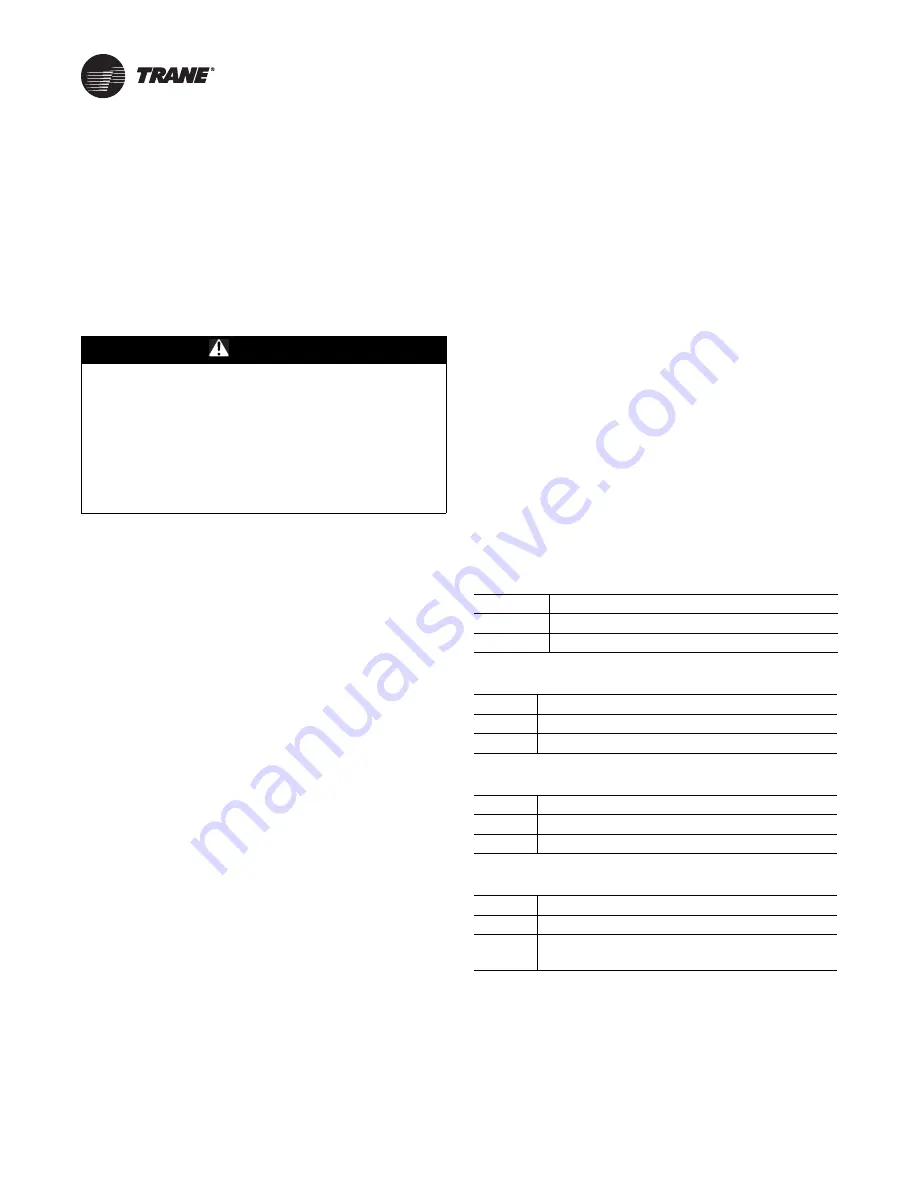
38
RT-SVX38C-EN
Troubleshooting
ReliaTel™ Control
The RTRM has the ability to provide the service personnel
with some unit diagnostics and system status information.
Before turning off the main power disconnect switch, use
the following steps to check the ReliaTel Refrigeration
Module (RTRM). All diagnostics and system status
information stored in the RTRM will be lost when the main
power is turned off.
To prevent injury or death from electrocution, it is the
responsibility of the technician to recognize this hazard
and use extreme care when performing service
procedures with the electrical power energized.
1.
Verify that the Liteport LED on the RTRM is burning
continuously. If the LED is lit, go to Step 3.
2. If the LED is not lit, verify that 24 VAC is present
between J1-1 and J1-2. If 24 VAC is present, proceed to
Step 3. If 24 VAC is not present, check the unit main
power supply and check the transformer (TNS1).
Proceed to Step 3 if necessary.
3. Using “Method 1” or “Method 2” in the “System
Status Diagnostic” section, check the following:
System status
Heating status
Cooling status
If a System failure is indicated, proceed to Step 4. If no
failures are indicated, proceed to Step 5.
4. If a System failure is indicated, recheck Steps 1 and 2.
If the LED is not lit in Step 1, and 24 VAC is present in
Step 2, the RTRM has failed. Replace the RTRM.
5. If no failures are indicated, use one of the TEST mode
procedures described in the “Unit Start-Up” section to
start the unit. This procedure allows you to check all of
the RTRM outputs and all of the external controls
(relays, contactors, etc.) that the RTRM outputs
energize, for each respective mode. Proceed to Step 6.
6. Step the system through all of the available modes,
and verify operation of all outputs, controls, and
modes. If a problem in operation is noted in any mode,
you may leave the system in that mode for up to one
hour while troubleshooting. Refer to the sequence of
operations for each mode, to assist in verifying proper
operation. Make the necessary repairs and proceed to
Steps 7 and 8.
7.
If no abnormal operating conditions appear in the test
mode, exit the test mode by turning the power to OFF
at the main power disconnect switch.
8. Refer to the individual component test procedures if
other microelectronic components are suspect.
System Status Checkout
Procedure
Check system status by using one of the following two
methods:
Method 1
If the Zone Sensor Module (ZSM) is equipped with a
remote panel with LED status indication, you can check the
unit within the space. If the ZSM does not have LEDs, use
Method 2. BAYSENS110*, BAYSENS109*, BAYSENS119*,
BAYSENS023A all have the remote panel indication
feature. The LED descriptions are listed below.
LED 1 (System)
LED 2 (Heat)
LED 3 (Cool)
LED 4 (Service)
The following sections contain a complete listing of failure
indication causes.
System failure
Check the voltage between terminals 6 and 9 on J6; it
should read approximately 32 VDC. If no voltage is
present, a system failure has occurred. Refer to Step 4 in
WARNING
Live Electrical Components!
During installation, testing, servicing and
troubleshooting of this product, it may be necessary to
work with live electrical components. Have a qualified
licensed electrician or other individual who has been
properly trained in handling live electrical components
perform these tasks. Failure to follow all electrical
safety precautions when exposed to live electrical
components could result in death or serious injury.
On
During normal operation
Off
If a system failure occurs or LED fails
Flashing
Indicates test mode
On
When the heat cycle is operating
Off
When the heat cycle terminates or LED fails
Flashing Indicates a heating failure
On
When the cooling cycle is operating
Off
When the cooling cycle terminates or LED fails
Flashing Indicates a cooling failure
On
Indicates a clogged filter
Off
During normal operation
Flashing Indicates an evaporator fan failure or
condensate overflow switch failure
Summary of Contents for RT-SVX38C-EN
Page 26: ...Installation 26 RT SVX38C EN Figure 28 Examples...
Page 45: ......
Page 46: ......
Page 47: ......

























